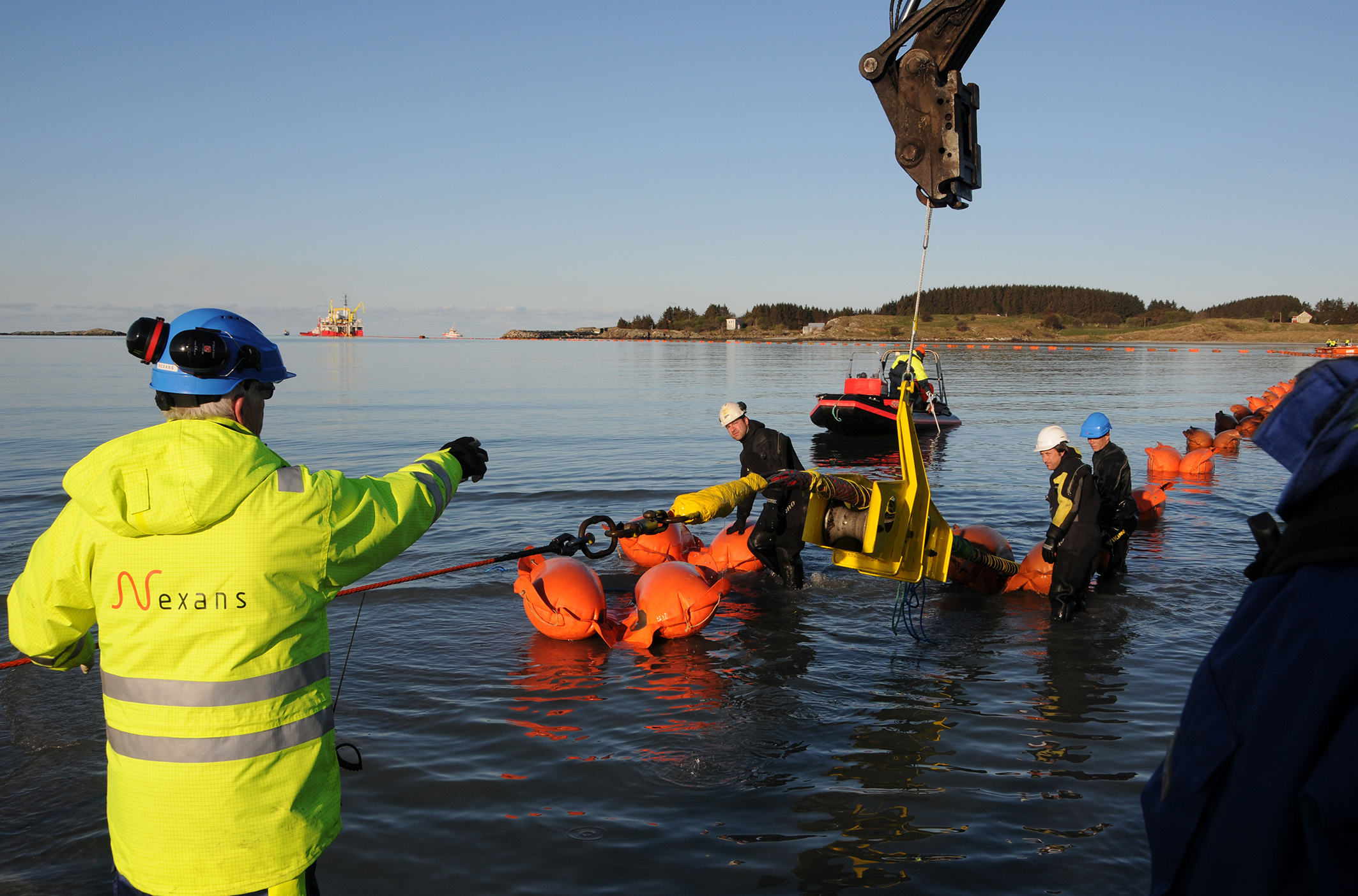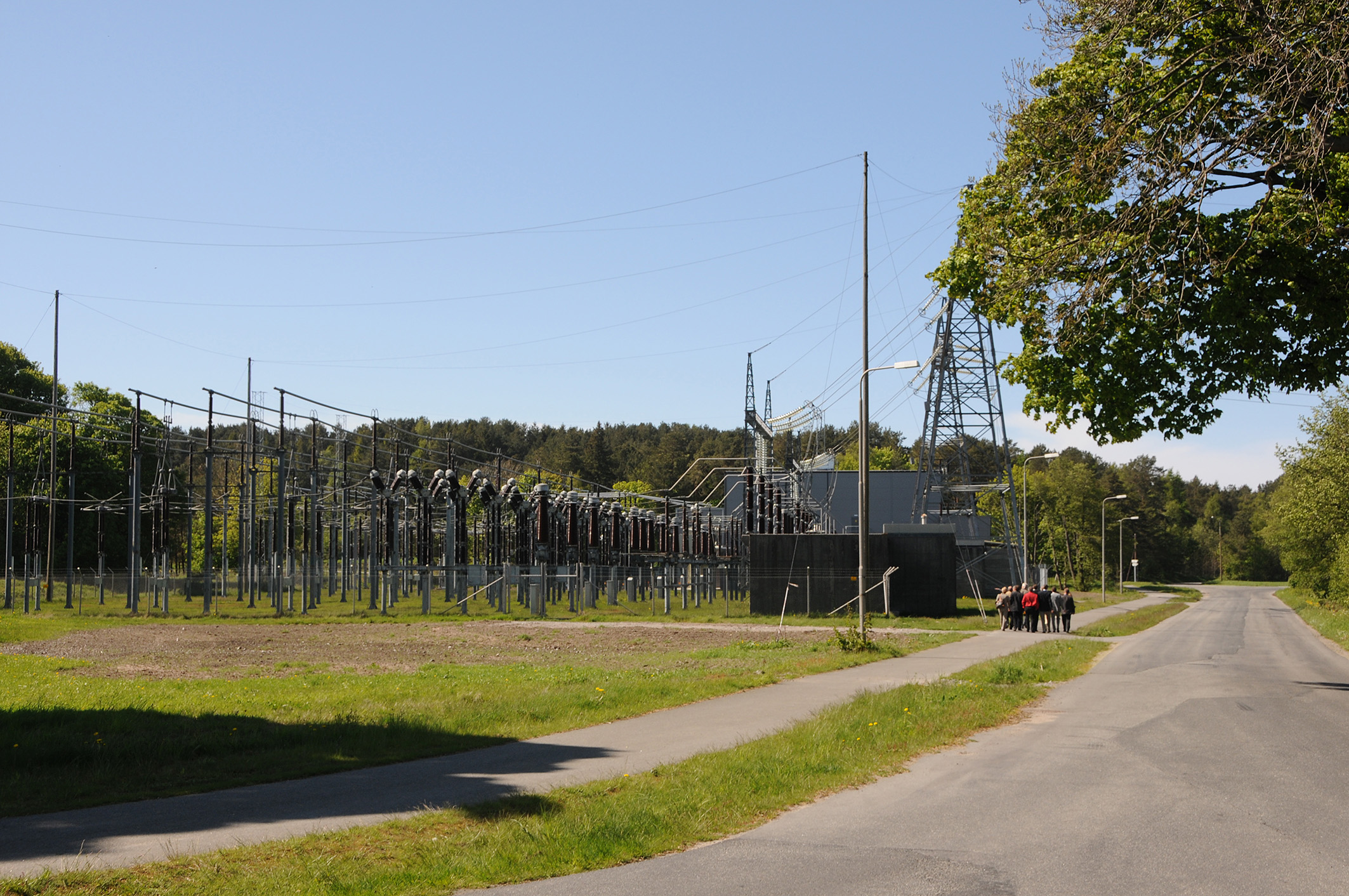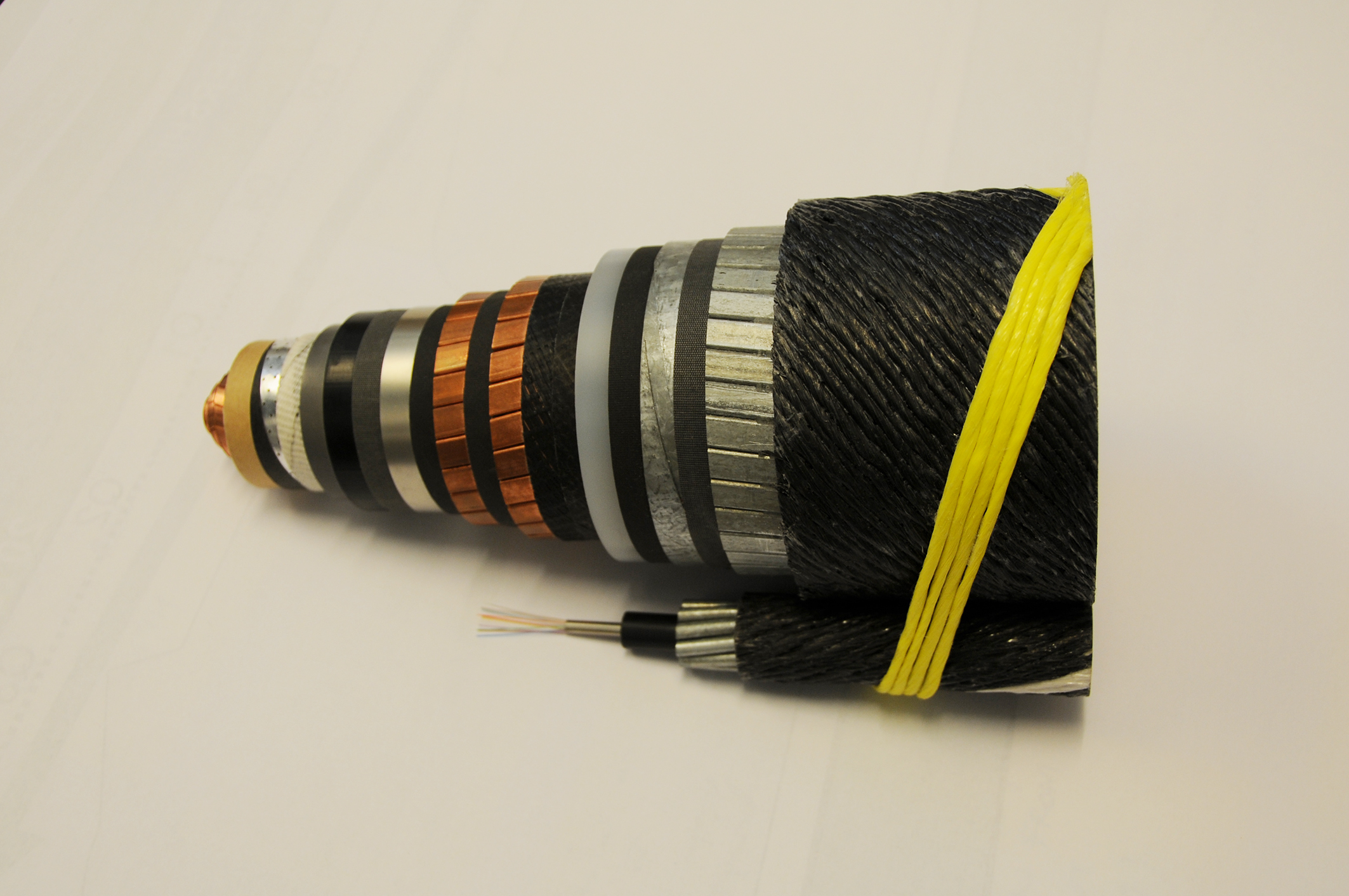Power from shore to Valhall

For and against
Offshore installations are “climate villains” in the eyes of many, accounting for a large proportion of Norway’s greenhouse gas emissions. The petroleum sector was responsible for 26 per cent of the carbon dioxide released by the country in 2012, with the bulk deriving from energy production by the platforms. Electricity consumed on the NCS usually comes from small local power stations, using gas turbines fuelled from production. Largely untreated, the exhaust fumes contain greenhouse gases.
 drift, Kraft fra land til Valhall
drift, Kraft fra land til ValhallGenerally speaking, the efficiency of the turbines – up to 40 per cent – is lower than for a gas-fired power station on land, which can achieve up to 60 per cent. That means lower utilisation of the energy potential in the fuel. Land-based power stations achieve a higher performance by combining gas and steam turbines to exploit waste heat. Because space on a platform is limited, such solutions are unusual offshore – although some installations have facilities of this kind with efficiencies close to 50 per cent.
The Norwegian government has been seeking to stabilise national greenhouse gas emissions since the late 1980s, and one
Some oil companies have nevertheless wanted to help reduce the volume of greenhouse gas emitted, and transmitting power from shore to offshore installations has been debated since the 1990s. This approach is considered particularly relevant in Norway because virtually all the country’s power takes the form of clean hydroelectricity. The government made it mandatory in 1997 to consider this option when planning new field developments or major conversion projects. However, it is not usually imposed as a direct order.measure aimed at achieving that goal is the carbon tax. Applied to the NCS since 1991, this impost makes it more expensive for the oil companies to operate with old gas-fired generating plant which releases a lot of carbon dioxide. Emissions of this gas from the oil and gas sector rose by 77.3 per cent from 1990 to 2012, despite the tax. This increase partly reflected the fact many more fields came on stream.
Reducing greenhouse gas emissions represents a key argument for power from shore. This is usually countered by the expense of installing it – particularly on existing installations. The costs involved have been confirmed by a number of reports and studies from government bodies, environmental organisations and the oil companies themselves.
Opting for clean energy
The decision to lay a submarine power cable from Norway to Valhall was taken in connection with the construction and installation of a new platform and the upgrading of other field facilities. Seabed subsidence meant that the original quarters platform was no longer sufficiently safe, and plans called for it to be replaced by a new process and hotel (Valhall PH) structure. That in turn permitted a modernisation and necessary upgrading of the production facilities on the field to keep it on stream up to 2050.
In addition, BP’s overall strategy was crucial for the solution chosen. The top management of the group had determined in 1998 that its greenhouse gas emissions per unit of oil produced were to be reduced by 10 per cent in 2010 compared with 1990.
 drift, Kraft fra land til Valhall
drift, Kraft fra land til ValhallA new logo was launched for BP in 2000. Known as Helios, from the Greek sun god, its colours of green, yellow and white reflect warmth, light and nature. Its design comprises interwoven shapes – just like the group itself, where unity is created by many different components working as one. That was particularly relevant after a number of mergers and acquisitions. This concept unified all the original companies and employees which now formed BP and its global brand.
In 2001, BP also introduced the “Beyond Petroleum” slogan to demonstrate that its attention now extended beyond oil and gas. Its initials would no longer stand for British Petroleum, and the group’s name is now only BP plc.
Around the beginning of the millennium, BP considered the idea of an electricity supply grid for offshore fields under the title “North Sea power projects”. That included assessments in collaboration with ConocoPhillips related to the Ekofisk region, including Valhall and Ula (also BP-operated) and nearby UK platforms. Such concepts were shelved in part because existing gas turbines could be modernised. A separate study concluded that partial power from shore for Ekofisk would not be profitable.
BP decided to continue work on a solution for Valhall, with a combined gas/steam turbine installation on the new platform versus electricity transmission from land.
The second of these was regarded as clearly superior in terms of reducing greenhouse gas emissions. A modern gas-fired power station offshore would release some 300 000 tonnes of carbon dioxide and 250 tonnes of nitrogen oxides per year. Electricity transmitted from Norway’s hydropower-based national grid, on the other hand, was presumed to involve virtually zero emissions.
 drift, Kraft fra land til Valhall
drift, Kraft fra land til ValhallAnother significant argument in favour of power from shore was that topside equipment would be lighter and need less maintenance. Gas turbines eventually require major overhauls and replacement. In financial terms, hydropower transmission involved a higher investment than the turbine-based solution but would reduce operating costs. Operational regularity would be improved. According to BP studies, that would make it possible to cut staffing and thereby reduce accommodation needs. Power from shore imposed costs related to substations on land and offshore, the submarine cable, operations, synergies with fibreoptic cables and the price of electricity.
Where safety is concerned, gas turbines present a risk of fire and explosion while in operation as well as generating a good deal of noise and heat. Power from shore improves the availability of electricity supply, unless the cable breaks – which could take up to six weeks to repair while production is at a standstill. Burying the cable reduces that risk.
Another source of uncertainty is how the petroleum industry would be prioritised if power rationing has to be imposed on the mainland. Electricity supplies could be disrupted for brief periods as a result of bad weather causing damage to the transmission grid, for example. Diesel generators have been installed on Valhall to maintain a certain level of staffing. But these will not have the capacity to sustain production.
The cost of installing power from shore was put at about NOK 1.8 billion in the plan for development and operation (PDO) of the Valhall redevelopment (VRD) project. This figure had reached roughly NOK 2 billion on completion.
Before the development decision was taken, a study was conducted to assess whether power from shore should be subsidised by the government. This work was done by specialists from the Norwegian Water Resources and Energy Directorate (NVE), the Norwegian Petroleum Directorate (NPD) and the Petroleum Safety Authority Norway (PSA). Their analysis concluded that it would not be a sensible policy to provide grants or other additional incentives for the project.
 drift, Kraft fra land til Valhall
drift, Kraft fra land til ValhallFollowing detailed assessments, it was decided in 2005 that the new Valhall PH platform would be powered entirely from shore. BP felt this was technically feasible, even though the field lies 294 kilometres from land. A licence had to be secured from the NVE to lay the cables and install transmission substations, and BP collaborated with grid operator Statnett on an application. This was submitted in April 2005 and approved that September.
Built at Lista near Norway’s southernmost tip, a transmission substation opened in May 2009 to convert alternating current (AC) from the electricity grid to direct current (DC). AC is easy to transform between different voltages and has therefore become standard in the power grid. But DC reduces losses from, and cuts the cost of, transmission over long distances. From Lista, the electricity is sent through the 294-kilometre submarine cable to Valhall and converted back to AC in order to power everything from heavy machinery to cabin lights.
Sverre Gilje was appointed an environmental hero by Norway’s Zero environmental foundation in 2010 for his commitment to power from shore for Valhall. Gilje was BP’s project manager. Screenshot from a YouTube video.



The Lista station is located adjacent to Alcoa’s aluminium plant, which collaborates with BP on its operation. Two power lines from Feda supply this part of Farsund local authority. In addition to a local power surplus, the area has a high electricity throughput because it is connected to other countries by submarine cable. The Valhall PH platform was installed in 2011 and came on stream in January 2013. Officially transferred to the operations department on 30 January 2012, the power-from-shore system could supply the whole field with electricity from that date.
Other projects
Valhall was not the first facility on the NCS to get electricity from land, since this had been installed for some individual platforms earlier. But it ranked as the first complete field to take this step, with the largest number of platforms and the longest distance from land. Troll A, one of several platforms on that field, came on stream in 1996 and has been operated throughout with power supplied via Kollsnes outside Bergen.
A primary reason for choosing this approach was the relatively short distance to land, a matter of 69 kilometres. Electricity requirements were also relatively low to begin with. Since then, however, gas compressors have been installed to compensate for declining reservoir pressure as the gas is produced. Power from shore has therefore had to be reinforced. The subsea developments for Ormen Lange in the Norwegian Sea and Snøhvit in the Barents Sea, with land-based terminals at Nyhamna and Melkøya respectively, utilise power from shore. Both came on stream in 2007.
From 2010, the Gjøa field west of the Sogne Fjord was provided with electricity through a 98-kilometre AC cable from land. A gas compressor has also been installed to support exports. The Goliat platform in the Barents Sea, due to come on stream in 2015, will also be supplied with power from shore through a 111-kilometre AC cable combined with a gas-turbine generator. Martin Linge in the northern North Sea, due to come on stream in late 2016, is to be developed solely with power from shore through a 162-kilometre AC cable. The Storting (parliament) approved the use of power from shore for the fields in the Utsira High areas of the North Sea – Edvard Grieg, Gina Krog, Ivar Aasen and Johan Sverdrup. This solution is politically sensitive, not least with regard to the costs involved. Johan Sverdrup is due to start receiving electricity via two 200-kilometre DC cables during 2019, and the other fields will follow by 2022.
Sources
BP Norge, 17 February 2006: Konsekvensutredning Forlenget levetid for Valhall .
BP Norge, April 2005: Likestrømsforbindelse til Valhall , Søknad om konsesjon, ekspropriasjonstillatelse og forhåndstiltredelse .
Buch, Kruse, and Palm, 1999, Sauar: Grønn kraft og varme. Miljøeffektive energiløsninger i det 21. århundre , Bellona report no 3.
ConocoPhillips, May 2012: Power from shore to the Ekofisk area , study report.
Gilje, Hyttinen and Westman, Oslo, 2010: Valhall re-development project, power from shore . Petroleum and Chemical Industry Committee Europe Conference.
Norwegian Official Reports (NOU) 2006 18: Et klimavennlig Norge (report from the low emission commission).
Norwegian Official Reports (NOU) 2012 9: Energiutredningen – verdiskaping, forsyningssikkerhet og miljø.
Norwegian Petroleum Directorate, October 2013: Vurdering av gjennomførte prosjekter på norsk sokkel , Stavanger.
Osmundsen, Petter, 2012: Elektrifisering som klimatiltak? En samfunnsøkonomisk analyse , Samfunnsøkonomen no 1.
Palm, Thomas, 2007: Et krafttak fra land: hvordan kraft fra land kan redusere utslippene fra norsk sokkel .
Report from the Zero Emission Resource Organisation, Oslo.
Rasen, Bjørn, 2007: LF6A. Valhall at 25 … and it’s only the beginning , Stavanger.
Proposition no 76 to the Storting (2006-2007): Utbygging og drift av Valhall videreutvikling.
Report no 14 to the Storting (2011-2012: Vi bygger Norge – om utbygging av strømnettet .
New process and hotel platform on Valhall